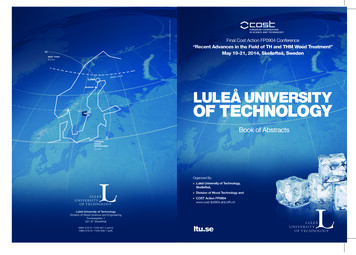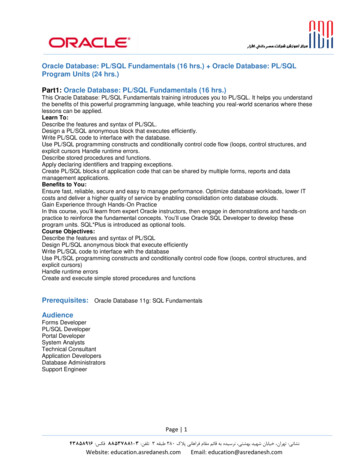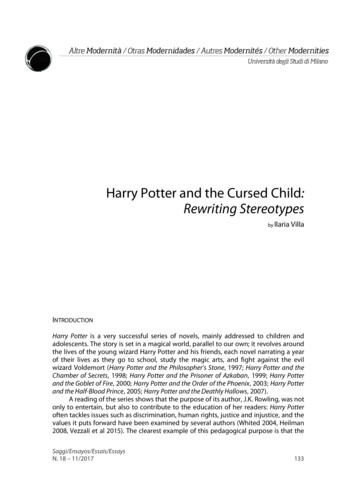
Transcription
Luleå University of Technology, Graphic Production 20149.5 hrsFinal Cost Action FP0904 Conference“Recent Advances in the Field of TH and THM Wood Treatment”May 19-21, 2014, Skellefteå, SwedencleArctic CirLULEÅ UNIVERSITYOF TECHNOLOGYStockholmBook of Abstracts3.5 hrsOrganized By: Luleå University of Technology,Skellefteå,Division of Wood Technology andCOST Action FP0904www.cost-fp0904.ahb.bfh.chLuleå University of TechnologyDivision of Wood Science and EngineeringForskargatan 1931 87 SkellefteåISBN 978-91-7439-937-0 (print)ISBN 978-91-7439-938-7 (pdf)ltu.se
PrefaceBook of abstracts includes the scientific program and the abstracts of papers will bepresented at the Final COST Action FP0904 Conference on “Recent Advances in theField of TH and THM Wood Treatment” at the Luleå University of Technology,Division of Wood Science and Engineering, in Skellefteå, Sweden on 19–21 May 2014.The main objective of COST Action FP0904 is to achieve a better understanding onmechanical and chemical transformations of wood during Thermo-Hydrous (TH)/ ThermoHydro-Mechanical (THM) processing through collaborations between different researchersfrom the wood and material sciences. This Action provides cooperation and encouragesresearch between research groups from academia and industry to help to overcome thechallenges in scaling-up research findings, improving full industrial production, processimprovement, in understanding the relations between the processing parameters, materialproperties and the development of new products. The COST Action FP0904 consists of threeWorking Groups (WGs):WG1: Identification of chemical degradation of wood under Thermo- Hydrous treatmentWG2: Modelling of Thermo-Hydro-Mechanical behaviour of wood during processingWG3: Innovation and new products by Thermo-Hydro-Mechanical processingWe wish the conference provides a forum and an opportunity for experts and youngresearchers from worldwide academia and industry to present their latest research, exchangingand developing new ideas within the field of TH and THM wood treatment. The objectives ofthis conference are to present and discuss the state-of–the-art of TH/THM wood treatment inopen and closed systems and the challenges in wood characterization and scaling-up fromlaboratory to full industrial production, through a discussion of the latest research results andnew ideas. The key objective of this Final Action FP0904 Conference is to present the mainresults of the Action, to summarise the scientific progress achieved and to formulate openquestions and further challenges. This conference will include an evaluation session withrepresentatives of COST and Action Management Committee members.Luleå University of Technolgy (LTU), established in 1971, is the northernmost University ofTechnology in Scandinavia and is known for its education and research within the field WoodScience and Engineering. The research area of Wood Technology, Wood Physics and WoodProducts Engineering is since 1982 established in the city of Skellefteå. Northern Sweden isone of the most important areas in Europe when it comes to forestry and the wood industry.The Wood Science and Engineering group at LTU are engaged in a wide range of fieldswithin the entire chain from forest to finished product.On behalf of the COST Action FP0904 Management Committee I would like to thankeverybody that kindly contributed to this meeting: all the authors and specially the keynotespeakers; Callum Hill, Eiichi Obataya, Otto Th. Eggert and Kevin Candelier.I gratefully acknowledge the help of the Scientific Advisory Committee in reviewing theabstracts and preparing the scientific program.I express my sincere gratitude to Dick Sandberg and Mojgan Vasiri for their works inpreparing the “book of abstracts” and also as the local organizer.Parviz NaviChair of COST Action FP0904Cost Action FP0904 Conference
Scientific Advisory CommitteeParviz NaviDennis JonesGeorge JeronimidisMark HughesMathieu PetrissansLennart SalmenJoseph GrilPeer HallerDick SandbergMojgan VasiriDr Christelle Ganne-ChedevilleLocal OrganisationDick SandbergMojgan VaziriWeb-page administrationMojgan VaziriTed KarlssonAccounting & AdminstrationFredrik DegermanEva-Stina NordlundCristoffer SchutzeBern University of Applied Sciences, SwitzerlandSP Technical Research Institute of SwedenReading University, United KingdomAalto University, FinlandUniversity Nancy 2, FranceInnventia Stockholm, SwedenUniversity Montpellier 2, FranceTechnische Universität Dresden, GermanyLuleå University of Technology, Skellefteå, SwedenLuleå University of Technology, Skellefteå, SwedenBern University of Applied Sciences, SwitzerlandLTU SkellefteåLTU SkellefteåLTU SkellefteåEditor-In-Chief , LTUEconomist, LTU SkellefteåInstitute's administrator, LTU SkellefteåProject administrarorRegistrarionMrs Inger LindbäckCost Action FP0904 ConferenceNEX meeting & event
General InformationsDATE18-21 MAYVENUEArenan at Campus SkellefteåOFFICIAL LANGUAGEThe official conference language will be English.BADGEDelegates must report to the registration desk to collect their name badgesand conference materials. Every participant including his/her accompanyingperson is requested to wear a name badge during theconference period.Venue : Lobby ArenanThe desk will also be operating during the following scheduleREGISTRATIONRECEPTION DESK18 May Sunday 14:00-16:3018 May Sunday 14:00-16:3019 May Monday 07:20-11:3020 May Tuesday 08:00-08:4021 May Wednesday 07:30-11:00Regarding Oral Presentations, please note that:It is expected that all presentations will be presented in English usingMicrosoft PowerPoint with a common computer provided by the conferenceorganizers. We encourage you to check your PowerPoint file compatibilityin advance. An overhead projector will be available by specialrequest.SPEAKER’SRECEPTION DESKIMPORTANT! All speakers are required to check in at the Speaker’sReception Desk by 18 & 19 May in order to hand over the CD or USB withthe PowerPoint file, to be downloaded on the conference computer.All speakers during Tuesday must hand in their presentations duringMonday May 19. The opening times for the Speaker’s Reception Desk arethe same as for the Information Des, Sunday 14:00-16:30 and Monday 7:2011:30.During Tuesday and Wednesday only by request in advance, (please contactthe General Information Desk for further assistance)Cost Action FP0904 Conference
ProgrammeTimeSUNDAYMAY 18TimeMONDAYMAY Opening session08:40-09:2009:20-10:00Session 1: Chemical degradationof wood under thermo-hydroustreatmentsKeynote 1: Callum Hill2 Full Oral Presentations10:00-10:30Coffee BreakTUESDAYMAY 20Session 3: New products byTHM-open systemKeynote 3: Otto Th. Eggert10:30-11:00Coffee Break11:00-11:40 2 Full Oral Presentations11:40-12:0012:00-13:305 Poster PresentationsLunchSession 4: Innovations andnew products laboratory13:30-14:10 and industrial scale & STSMpresentationsKeynote 4: Kévin Candelier2 Full Oral Presentations14:10-15:10 3 Full Oral Presentations11:10-11:306 Poster Presentations15:10-15:40Lunch13:00-13:40Session 2: Modeling of THMprocessing and predicting thebehavior of THMKeynote 2: Eiichi Obataya13:40-14:202 Full Oral 00-18:30 And Welcome 15:50-16:13Reception16:15-18:00Coffee Break3 Full Oral Presentations7 Poster PresentationsPosters&Visit To LTU LaboratoryCost Action FP0904 ConferenceWEDNESDAYMAY 2108:00-08:30Coffee08:30-10:30Management CommitteeMeeting and theEvaluation Panel (Closedsession)09:30-10:30 3 Full Oral 19:00-22:00Coffee Break8 Oral Presentations& 2 Poster PresentationsConference Dinner
ProgrammeSUNDAYMAY 18THRegistration And Welcome Rception14:00-18:30MONDAYMAY 19TH07:20-08:20Registration At the Desk (Conference Place)08:20-08:40Opening Session08:40-09:2009:20-09:4009:40-10:00Session 1: Chemical degradation of wood under thermo-hydrous treatmentsChairperson: Mark HughesKeynote 1: Callum Hill, Thermally Modified Wood – the role of hemicelluloses, p. 1Full O.pres 1:1 Wim WillemsCharacterisation of thermally modified wood by a novel means of moisturesorption isotherm analysis, p. 3Full O.pres 1:2 Wieslaw Olek, Patrick Perré, Jerzy Weres, Romain RémondWater diffusivity of thermally modified beech wood, p. 5Coffee Break10:00-10:3010:30-10:50Full O.pres 1:3 Michael Altgen, Jukka Ala-Viikari, Timo Tetri, Antti Hukka, HolgerMilitzThe impact of elevated steam pressure during the thermal modification of Scotspine and Norway spruce, p. 710:50-11:10Full O.pres 1:4 Iris Brémaud, Sandrine Bardet, Joseph Gril, Patrick PerréEffects of water re-saturation conditions and associated extractives leaching onthermal softening of wet wood, p. 8Poster Session11:10-11:3011:12-11:15Poster 1:1 Lukas Brösel, Lothar Clauder, Alexander PfriemFlammability tests on thermally modified and untreated timbers, p. 1011:15-11:18Poster 1:2 Mohamed Tahar Elaieb, Kevin Candelier, Anélie Petrissans, StéphaneDumarcay, Philip Gerardin, Mathieu PetrissansChemical modification during heat treatment of Tunisian soft wood species, p. 1211:18-11:21Poster 1:3 Lorenzo Barnini, Giacomo Goli, Marco FioravantiEffect of steam saturated atmosphere on some physical and mechanicalproperties of poplar wood, p. 1411:21-11:2411:24-11:27Poster 1:4 Olov Karlsson, Ola Dagbro, Kurt GranlundSoluble degradation products in thermally modified wood, p. 16Poster 1:5 Maria-Cristina Popescu, Carmen-Mihaela PopescuAn NIR and XPS study of the lime wood samples modified for differentperiods at lower temperature and relative humidity, p. 1811:27-11:30Poster 1:6 M. Hakki Alma, Eyyup Karaogula, Tufan Salanb, Nasir Narlioglua, H.İbrahim Şahinc, Cengiz GülerEffect of thermal treatment on XRD, ATR-FTIR AND SEM analysis of several woodspecies, p. 2011:30-13:00LunchCost Action FP0904 Conference
Programme13:00-13:40Session 2: Modeling of THM processing and predicting the behavior of THMChairperson: Joseph GrilKeynote 2: Eiichi Obataya, Recoverable effects of heat treatment, p. 2113:40-14:00Full O.pres 2:1 Sung-Lam Nguyen, Omar Saifouni, Jean-François Destrebecq,Rostand Moutou PittiAn incremental model for wood behaviour including hydro-lock effect, p. 2414:00-14:20Full O.pres 2:2 Andreja Kutnar, Frederick A. Kamke, William GacitúaElastic cell wall modulus and hardness of S2 layer and middle lamella inviscoelastic thermal compressed wood, 26Coffee Break14:20-14:5014:50-15:10Full O.pres 2:3 Giacomo Goli, Bertrand Marcon, Marco FioravantiWood heat treatment modifications: effects of initial moisture and airexchange rate on kinetic and final product characteristics, p. 2815:10-15:30Full O.pres 2:4 35Patrick PERRE, Romain REMONDA comprehensive dual-scale computational model able to simulate the heattreatment of a thick-bed of particles or boards, p. 3015:30-15:50Full O.pres 2:5 Hassen Riahi, Rostand Moutou Pitti, Frédéric DuboisNumerical analysis of timber fracture due to mechanical and thermal loads: anapproach based on invariant integral A, p. 32Poster Session15:50-16:1315:52-15:5515:55-15:58Poster 2:1 Hassen Riahi, Rostand Moutou Pitti, Alaa Chateauneuf, Frédéric DuboisStochastic analysis of mixed mode fracture in timber material using polynomialchaos expansion, p. 34Poster 2:2 Dang Djily, Rostand Moutou Pitti, Evelyne Toussaint, Michel GrédiacExperimental evidence of water diffusion gradient in wood using the grid method,p. 3615:58-16:01Poster 2:3 Emilia-Adela Salca, Salim HizirogluEvaluation of roughness and hardness of heat treated wood species, p. 3816:01-16:04Poster 2:4 Bogdan Bedelean, Daniela SovaInfluence of air parameters on drying time and energy consumption duringthermo-hydro processing of wood, p. 4016:04-16:07Poster 2:5 Alexey Vorobyev, Nico van Dijk, Ingela Bjurhager, E. Kristofer GamstedtDetermination of elastic behaviour of precious samples from large wooden structures of cultural heritage including screening potential in process treatment, p. 4216:07-16:10Poster 2:6 Cécilia Gauvin, Kaoru Endo, Delphine Jullien, Eiichi Obataya, Joseph GrilEffect of hygrothermal treatments on the physical properties of wood, p. 4316:10-16:13Poster 2:7 Mojgan Vaziri, Sven Berg, Dick SandbergThree-dimensional finite element modelling of heat transfer forlinear friction welding of Scots pine, 45Posters16:15-18:00Cost Action FP0904 Conference&Visit To LTU Laboratory
ProgrammeTUESDAYMAY 20TH9:00-9:309:30-9:509:50-10:1010:10-10:30Session 3: Innovation and new products in THM treatmentsChairperson: Peer HallerKeynote 3: Otto Th. Eggert, Solid wood bending – a stunning production system,p. 47Full O.pres 3:1 Jörg Wehsener, Jens Hartig, Peer HallerInvestigations on the recovery behaviour of beech (Fagussylvatica) wood densified transverse to the grain, p. 48Full O.pres 3:2 Lars Blomqvist, Jimmy Johansson, Dick SandbergModification of surface veneer to reduce damage in laminatedveneer products during manufacturing, p. 50Full O.pres 3:3 Róbert Németh, József Ábrahám, Mátyás BáderEffect of high temperature treatment on selected properties ofbeech, hornbeam and turkey oak wood, p. 52Coffee Break10:30-11:0011:00-11:20Full O.pres 3:4 Alexander PfriemThermally modified wood for use in musical instruments – a review, p. 5411:20-11:40Full O.pres 3:5 Nozomi Takemura, Aoi Hirano, Eiichi Obataya, Koji AdachiCompressive elasticity of compressed wood and its application to flexiblewooden beam, p. 56Poster 111:51-11:5411:54-11:57Poster 3:1 Aleš Straže, Miljenko Klarić , Stjepan Pervan, Silvana Prekrat, ŽeljkoGorišekAccelerated artificial ageing of thermally treated ash wood, p. 58Poster 3:2 Lothar Clauder, Alexander PfriemComparative durability tests on TMT Beech – preliminary results, p. 60Poster 3:3 Veikko Möttönen, Juhani Marttila, Jukka Antikainen, Henrik Heräjärvi,Erkki VerkasaloColour, MOE and MOR of silver birch and European aspen wood aftercompression and thermal modification in an industrial scale modificationchamber, p. 62Poster 3:4 Ali Akbar Enayati, Fatemeh Taheri, Razieh MosayyebiEffect of heat treatment conditions(Heat-temperature and Initial (MoistureContent )on the pH value and buffer capacity of Poplar Wood (Populous alba),p. 63Poster 3:5 Marek GrześkiewiczEffect of thermal modification of beech wood on its MOE and othermechanical properties, p. 6512:00-13:30Cost Action FP0904 ConferenceLunch
:10Session 4: Environmental impact assessment of THM products& STSM presentationsChairperson: Andreja KutnarKeynote 4: Kévin Candelier, Characterization of physical and chemical changesoccurring during wood thermal degradation. Influence of treatment intensity,wood species and inert atmosphere, p. 67Full O.pres 4:1 Michael Burnard, Andreja KutnarRestorative environmental design: A design paradigm for thermally modifiedwood, p. 70Full O.pres 4:2 José Sánchez del Pulgar, Illaria Santoni, Luca Cappellin, AnreaRomano, Cuccui Ignazia, Franco Biasioli, Ottaviano AllegrettiRapid assessment by PTR-ToF-MS of the effect on volatile compound emissionof different heat treatments on larch and spruce, p. 72Full O.pres 4:3 Carmen-Mihaela Popescu, Maria-Cristina Popescu, PetronelaGradinariuSoft and white rot degradation resistance of thermo-hydro-mechanicalprocessed hardwood evaluated by infrared spectroscopy, p. 74Coffee Break15:10-15:4015:40-16:00Full O.pres 4:4 Ekaterina Sidorova, Sheikh A. Ahmed, Diego ElustondoWood thermal-modification at Luleå University of Technology, p. 7616:00-16:10Short O.pres 4:5 Carmen Cristescu, Dick SandbergSelf-bonding of veneers with heat and pressure– a full scale test, p. 7716:10-16:20Short O.pres 4:6 Nebojša Todorović, Goran Milić, Zdravko PopovićEstimation of heat-treated beech wood properties by FT-NIRspectroscopy: effect of radial and cross sectional surface, p. 7816:20-15:50Poster Session/STSM Presentation 816:48-16:58Poster 4:1 Jonaz Nilsson, Jimmy Johansson, Dick SandbergDensified and thermally modified wood as outer layers in lightweight panels for furniture and joinery, p. 80Poster 4:2 Sandak Jakub, Riggio Mariapaola, Pauliny Dusan, Sandak AnnaDensified wood as a resource for novel nail-like connectors, p. 82Short O.pres 5:1 Wim Willems, Joël Hamada, Mathieu Pétrissans, PhilippeGérardin, Characterization of thermally modified wood by oxygen bombcalorimetry, p. 84Short O.pres 5:2 Mirko Kariz, Manja Kitek Kuzman, Milan Sernek, Mark Hughes,Lauri Rautkari, Frederick A. Kamke, Andreja KutnarInfluence of temperature of thermal modification on compressive densificationof spruce, p. 86Short O.pres 5:3 Lothar Clauder, Alexander Pfriem, Maria Rådemar, Lars Rosell,Marcus VestergrenEmissions from TMT products, p. 88Cost Action FP0904 Conference
Programme16:58-17:08Short O.pres 5:4 Kristiina Laine, Lauri Rautkari, Mark Hughes, KristofferSegerholm, Magnus WålinderSet-recovery and micromorphology of surface densified wood, p. 9017:08-17:18Short O.pres 5:5 Susanna Källbom, Lauri Rautkari, Magnus Wålinder, DennisJones, Kristoffer SegerholmWater vapour sorption properties and surface chemical analysisof thermally modified wood particles, p. 92Conference Dinner19:00-22:00WEDNESDAYMAY 21THCoffee08:00-08:308:30-10:30Management committee meeting with the COST representativeand the evaluation panel (Closed Session)Sandberg D. and Vaziri M. (Eds.)Cost Action FP0904 Conference
ProgrammeAbstractsCost Action FP0904 Conference
Thermally Modified Wood – the role of hemicellulosesCallum HillNorsk Institutt for Skog og Landskap, Ås, Norway, andJCH Industrial Ecology Limited, Bangor, UKenquiries@jchindustrial.co.ukKeywords: water vapour, sorption, hydroxyl groups, hemicelluloses, mechanical propertiesThermal modification reduces the hygroscopicity of wood. The reason for this is generally attributed to a reduction ofhydroxyl groups, as a result of degradation of the thermally labile macromolecular components of the cell wall (primarily thehemicelluloses). But how important is this mechanism? Degradation of the hemicelluloses is also responsible for changingthe modulus of the cell wall; thermally modified wood is stiffer (and more brittle) than unmodified wood. The threemacromolecular cell wall components of wood have specific roles to play in determining the properties of the wood cell walland in this paper, attention will be paid to the hemicelluloses and the roles that they play in determining the properties ofwood. The cellulose microfibril comprises the tensile reinforcement of the wood cell wall, exhibiting exceedingly a highmodulus of elasticity (of the order of 145 GPa) under tension. However, although strong in tension, cellulose microfibrilsbuckle easily when subjected to a compressive load. Lignin has the role of providing a rigid enveloping matrix for themicrofibril in order to provide resistance to compressive loads. But the surface of the microfibril is highly polar, with a highdensity of OH groups on the surface; whereas the lignin matrix has a much lower OH to carbon ratio. This results in a lowadhesive interaction and hence poor interfacial stress transfer between the microfibril and the surface. One role of thehemicelluloses is to act as an interfacial coupling agent between the surface of the microfibril and the lignin matrix. Somemicrofibrils have a molecular geometry in regions of the structure that allows for close contact with the surface of amicrofibril (or at least a cellulose chain) where there are chains of β-(1,4)-linked pyranose monomers. Examples of suchstructures include the glucose backbone in xyloglucans which are the most abundant hemicelluloses in dicotyledon cell walls.Xyloglucan molecules have been isolated with lengths of up to 700 nm, long enough to easily span the intermicrofibrillarspaces in the cell wall many times. The β-(1,4)-linked glucose backbone has frequent substitutions at the glucose C-6 positionb
Reception Desk by 18 & 19 May in order to hand over the CD or USB with the PowerPoint file, to be downloaded on the conference computer. All speakers during Tuesday must hand in their presentations during Monday May 19. The opening times for the Speaker’s Reception Desk are the same as for











